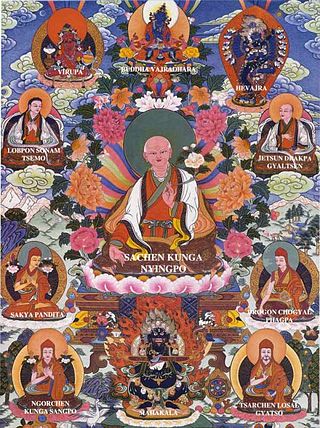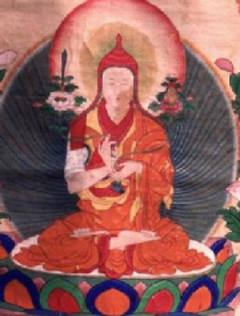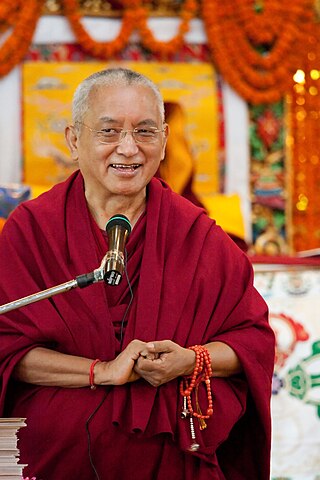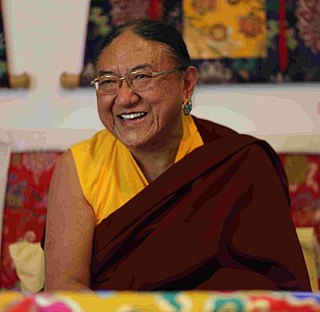
Padmasambhava, also known as Guru Rinpoche, was a semi-legendary tantric Buddhist Vajra master from India who fully revealed the Vajrayana in Tibet, circa 8th – 9th centuries. He is considered an emanation or Nirmāṇakāya of Shakyamuni Buddha as foretold by the Buddha himself. According to early Tibetan sources including the Testament of Ba, he came to Tibet in the 8th century and designed Samye Monastery, the first Buddhist monastery in Tibet during the reign of King Trisong Detsen. He, the king, and Khenpo Shantarakshita are also responsible for creating the Tibetan Canon through translating all of the Buddha's teachings and their commentaries into the Tibetan language.

The Sakya school is one of four major schools of Tibetan Buddhism, the others being the Nyingma, Kagyu, and Gelug. It is one of the Red Hat Orders along with the Nyingma and Kagyu.
A tulku is a distinctive and significant aspect of Tibetan Buddhism, embodying the concept of enlightened beings taking corporeal forms to continue the lineage of specific teachings. The term "tulku" has its origins in the Tibetan word "sprul sku", which originally referred to an emperor or ruler taking human form on Earth, signifying a divine incarnation. Over time, this term evolved within Tibetan Buddhism to denote the corporeal existence of highly accomplished Buddhist masters whose purpose is to ensure the preservation and transmission of a particular lineage.

The Rimé movement is a movement or tendency in Tibetan Buddhism which promotes non-sectarianism and universalism. Teachers from all branches of Tibetan Buddhism – Sakya, Kagyu, Nyingma, Jonang, Gelug, and Bon – have been involved in the promoting Rimé ideals.

Thrangu Rinpoche was born in Kham, Tibet. He was deemed to be a prominent tulku in the Kagyu school of Tibetan Buddhism, the ninth reincarnation in his particular line. His full name and title was the Very Venerable Ninth Khenchen Thrangu Tulku, Karma Lodrö Lungrik Maway Senge. The academic title Khenchen denotes great scholarly accomplishment, and the term Rinpoche is a Tibetan devotional title which may be accorded to respected teachers and exemplars.

Jamgön Kongtrül Lodrö Thayé, also known as Jamgön Kongtrül the Great, was a Tibetan Buddhist scholar, poet, artist, physician, tertön and polymath. He is credited as one of the founders of the Rimé movement (non-sectarian), compiling what is known as the "Five Great Treasuries". He achieved great renown as a scholar and writer, especially among the Nyingma and Kagyu lineages and composed over 90 volumes of Buddhist writing, including his magnum opus, The Treasury of Knowledge.

Thubten Zopa Rinpoche was a Tibetan Buddhist lama in the Gelug school. He is known for founding the Foundation for the Preservation of the Mahayana Tradition and Maitripa College in Portland, Oregon.

Kyabje Dudjom Rinpoche Jigdral Yeshe Dorje was known simply as Dudjom Rinpoche. He is considered by many Tibetan Buddhists to be from an important Tulku lineage of Terton Dudul Dorje (1615–1672), and was recognized as the incarnation of Terton Dudjom Lingpa (1835–1904), a renowned treasure revealer. He was a direct incarnation of both Padmasambhava and Dudjom Lingpa. He was a Nyingma householder, a yogi, and a Vajrayana and Dzogchen master. According to his secretary Khenpo Tsewang Dongyal and many others, he was revered as "His Holiness" (Kyabje) and as a "Master of Masters".
Nenang Pawo is one of the highest lamas of the Karma Kagyu school of Tibetan Buddhism. The Pawos form a lineage of tulkus, of which the first was born in 1440. They were traditionally the heads of Nenang Monastery in Ü-Tsang.
Shabdrung Lama Kunga Thartse Rinpoche is a Tibetan teacher of the Sakya school of Vajrayana Tibetan Buddhism. Lama Kunga Rinpoche is licensed in California to perform marriages with a Tibetan Buddhist ceremony.

Serme Khen Rinpoche Geshe Tashi Tsering BEM is abbot of Sera Mey Monastic University in India. From 1994 to 2018, he was the resident Tibetan Buddhist teacher at Jamyang Buddhist Centre, London.
E. Gene Smith was a scholar of Tibetology, specifically Tibetan literature and history.
Nāroḍākinī is a deity in Vajrayana Buddhism similar to Vajrayogini who no longer appears in the active pantheon despite her importance in late Indian Buddhism.
Khunu Lama Tenzin Gyaltsen was a Tibetan Buddhist scholar and teacher in the Rimé tradition, a Dzogchen master, and a teacher of several important Rinpoches of the late 20th century, including the 14th Dalai Lama. He hailed from Kinnaur, India. He was also known also as Negi Lama Tenzin Gyaltsen, Tenzin Gyaltsen, and various other names like Kunu Rinpoche, Kunu Lama, and Negi Lama.
Songs of realization, or Songs of Experience, are sung poetry forms characteristic of the tantric movement in both Vajrayana Buddhism and in Hinduism. Doha is also a specific poetic form. Various forms of these songs exist, including caryagiti, or 'performance songs' and vajragiti, or 'diamond songs', sometimes translated as vajra songs and doha, also called doha songs, distinguishing them from the unsung Indian poetry form of the doha. According to Roger Jackson, caryagiti and vajragiti "differ generically from dohās because of their different context and function"; the doha being primarily spiritual aphorisms expressed in the form of rhyming couplets whilst caryagiti are stand-alone performance songs and vajragiti are songs that can only be understood in the context of a ganachakra or tantric feast. Many collections of songs of realization are preserved in the Tibetan Buddhist canon, however many of these texts have yet to be translated from the Tibetan language.

Jigdal Dagchen Sakya Rinpoche was a Tibetan Buddhist teacher educated in the Sakya sect. He was educated to be the head of the Sakya school of Tibetan Buddhism as well as the successor to the throne of Sakya, the third most important political position in Tibet in early times. Dagchen Rinpoche was in the twenty-sixth generation of the Sakya-Khön lineage descended from Khön Könchok Gyalpo and was regarded as an embodiment of Manjushri as well as the rebirth of a Sakya Lama from the Ngor sub-school, Ewam Luding Khenchen Gyase Chökyi Nyima.

Tashi delek is a Tibetan expression used to greet, congratulate or wish someone good luck. It is also used in Bhutan and Northeast India in the same way. Tashi delek is associated with Losar, the Tibetan festival celebrating the lunisolar new year.

Turrell Verl "Terry" Wylie was an American scholar, Tibetologist, sinologist and professor known as one of the 20th century's leading scholars of Tibet. He taught as a professor of Tibetan Studies at the University of Washington and served as the first chair of the Department of Asian Languages and Literature. Wylie founded the Tibetan Studies program at the University of Washington, the first of its kind in the United States, setting a major precedent for future programs and research in the field. His system for rendering the Tibetan language in Latin script, known as Wylie transliteration, is the primary system used for transcribing Tibetan in academic and historical contexts.

Ratna Vajra Rinpoche, is a Tibetan Buddhist teacher who served as the 42nd Sakya Trizin from 2017 to 2022, considered one of the highest qualified lineage masters of both the esoteric and exoteric traditions of Buddhist philosophy and meditation. He is a descendant of the famous Khon family in Tibet, which holds an unbroken lineage of great and famous masters for over a thousand years. He is the eldest son of the 41st Sakya Trizin Ngawang Kunga. He teaches Buddhism and travels extensively throughout Europe, Asia, Australia, New Zealand and North America. Ratna Vajra was enthroned as the head of the Sakya school on 9 March 2017. On 16 March 2022, the throne of the Sakya school was passed by Ratna Vajra to his younger brother Gyana Vajra, who became the 43rd Sakya Trizin.

Sakya Trizin Ngawang Kunga served as the 41st Sakya Trizin, the throne holder of the Sakya Lineage of Tibetan Buddhism, from his appointment in 1952 until his retirement in 2017. His religious name is Ngawang Kunga Tegchen Palbar Trinley Samphel Wangyi Gyalpo. After passing the throne of the Sakya lineage to his elder son Ratna Vajra Rinpoche who became the 42nd Sakya Trizin on 9 March 2017, he is now known as Kyabgon Gongma Trichen Rinpoche.














